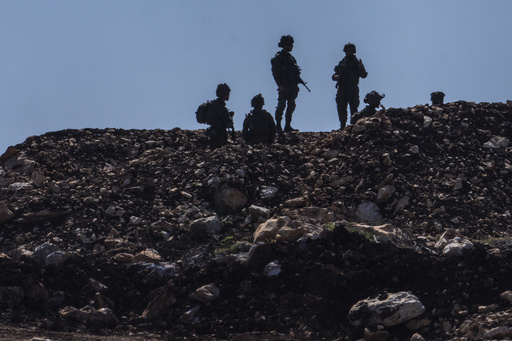KFAR KILA, Lebanon — On Tuesday, Israeli troops pulled back from several border villages in southern Lebanon, adhering to the timeline outlined in a U.S.-mediated ceasefire agreement that concluded the recent conflict between Israel and Hezbollah. However, Israeli forces maintained their positions at five critical observation points located within Lebanese territory.
This ongoing military presence has incited strong backlash from top Lebanese officials who described it as an occupation and a breach of the ceasefire agreement, which stipulated a complete Israeli withdrawal by the set deadline. The presence of Israeli troops continues to be a contentious issue for the militant group Hezbollah, which has been vocal in urging Lebanese authorities to address the situation.
In the aftermath of this military maneuver, Lebanese soldiers moved into the areas vacated by Israeli forces and began dismantling barriers previously erected by the Israelis while also searching for unexploded ordnance. They restricted access on major roadways leading into the villages to ensure safety during their investigations. Despite the restrictions, some residents ventured past the roadblocks, eager to assess the state of their homes. In several instances, the military permitted residents to enter.
The toll of the ongoing conflict is evident, with many homes either destroyed in the year-long combat or damaged during the two-month period following November’s ceasefire when Israeli troops still held occupation in the region. In Kfar Kila, witnesses were left in disbelief at the level of devastation, with entire blocks of homes decimated. Some residents took to their knees, praying in the village center.
Khodor Suleiman, a local construction contractor, expressed his shock at the destruction of his family home, which he had not visited for six months. “I am in a state of shock,” he said, caught between feelings of gratitude for returning and sorrow for what he found. As Lebanese troops worked to clear the debris in the village square, a young man shouted in excitement, revealing the discovery of two survivors who had been hiding since the onset of the conflict.
An ambulance quickly arrived to assist the two men, both reportedly members of Hezbollah, who had been sheltering in a grocery store for three months. Abbas Fadallah, a Shiite Muslim cleric whose family home was reduced to rubble, lamented the loss of life and history, as his residence was constructed over a century ago.
Hassan Sheet, the mayor of Kfar Kila, provided a somber assessment of the village’s condition, stating that approximately 90% of the homes were entirely destroyed and the remaining houses were damaged. He indicated that any reconstruction efforts would need to start anew from the ground up.
Amidst the destruction, Ayman Jaber visited the nearby village of Mhaibib, which had suffered extensive damage due to explosive blasts. He recalled fears of losing his newly built home to the conflict, fears that sadly came true as he reported, “Not a single house in the village is still standing.” Standing in the cemetery, he expressed sorrow at the disrespect shown to the deceased, whose graves were disturbed.
In response to the situation, Israeli Defense Minister Israel Katz announced that the Israeli military would retain a presence across five control posts within a buffer zone in Lebanon to guard against potential violations by Hezbollah. He further noted the establishment of new posts on the Israeli side of the border and the deployment of reinforcements.
However, the top three officials in Lebanon — the president, prime minister, and parliament speaker — released a unified statement declaring that Israel’s ongoing presence at these five locations contravened the ceasefire agreement. They urged the U.N. Security Council to intervene and enforce a full withdrawal of Israeli forces, asserting that any Israeli military presence constitutes an occupation under international law.
Similarly, the Israeli military’s position was condemned by U.N. officials, including the special coordinator for Lebanon and the leader of the U.N. peacekeeping forces in the region. Despite criticisms, they noted the progress that had occurred since the ceasefire agreement.
The conflict began escalating on October 8, 2023, following a deadly attack led by Hamas in southern Israel, igniting hostilities that resulted in a full-scale war by late September 2023. This brutal conflict led to over 4,000 fatalities in Lebanon and displaced more than a million people, leaving many unable to return home, along with dozens of casualties in Israel and tens of thousands displaced from their residences.
Hussein Fares, who fled Kfar Kila in October 2023 for Nabatiyeh, later sought shelter for his family in Sidon as fighting intensified. He expressed a longing to return, stating, “I have been waiting for a year and a half to return,” while acknowledging the lengthy process of reconstruction ahead.




